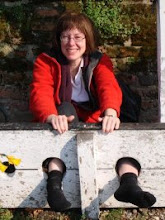


Here is a quilt that I bought recently. An elderly lady had brought in four quilts, that she and her WI (Womens Institute) group had made in the late 30's and early 40's, to sell through an auction point. This is one of them. All four sold quickly as they had been very much undervalued. Many members of the public and so-called antiques experts have no real appreciation of the value of textiles. This seems especially the case inthe areas where quilts were made and quilts are regarded as commonplace.
The quilt is 85 x 94 inches. It was sold as a "summer quilt" ie a light weight one with thinner cotton wadding. The colour is salmon on both sides. It looks unused, although there are some faded areas.
The auctionpoint was in Sunderland and although the sellers name was not released, the auctioneer hazarded a guess that the WI group might have been in the Sunderland or Washington area.
There is a wide outer margin with two lines of machine stitching. The quilting is fine, at 12 - 14 stitches, but not very even and is rather erratic in places. This might be expected in a group quilt with several people working together. The design is large but striking, with curved feathers and diamond infill (variable). There is some clamshell infill, and a square centre with more curved feathers, daiseys and some spiral infill. Although unused, there is no pencil marking evident.
The Womens Institute did much to keep quilting alive during and after the war. Post war, it held classes and exhibitions. It also published a booklet - Quilting, by Kay, Marchbank and Showler. My copy dates from 1979. It shows only two methods of finishing a quilt - a piped edge and a hand sewn edge. Machine stitched edges were supposedly frowned upon, thus I was a bit amused to find this WI quilt with machine finished edges. The habit of machining the edges must have been a longstanding one in the northeast.
In the book , there is much practical advice about marking and designing a quilt - and mentions effective design, the scale of infill in relation to motifs, and the effective marking of feathers. This quilt shows that the WI did achieve an improvement of design over that practiced by the other surviving groups. However, in reality, the designs are similar to the club quilts in that the motifs are usually a few larger and striking templates that cover the cloth with an economy of sewing.

I will have to do a search and see if I can find that booklet.
ReplyDeleteLove the salmon color of this quilt, the quilting is just so beautiful
thank you for sharing with us, I always am amazed at the hand quilting.
Kathie